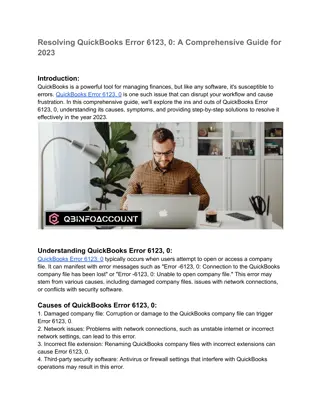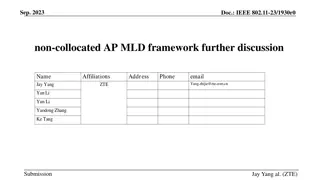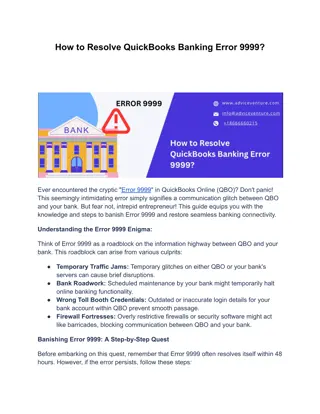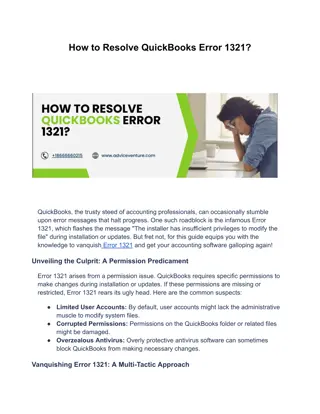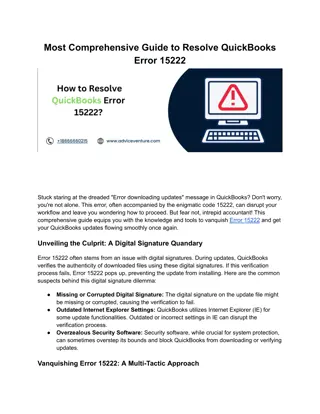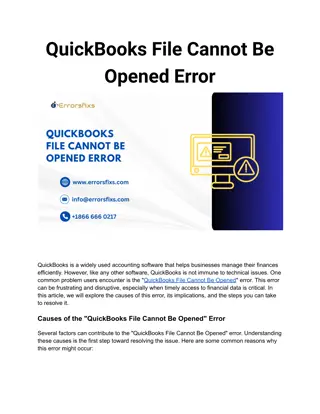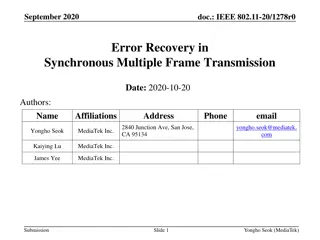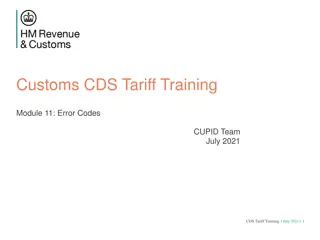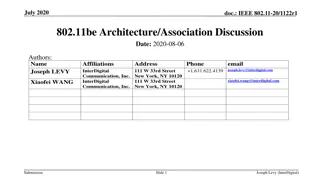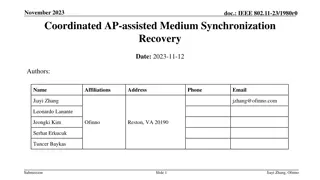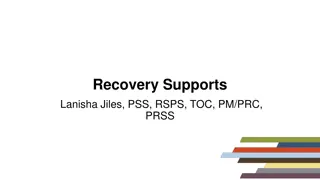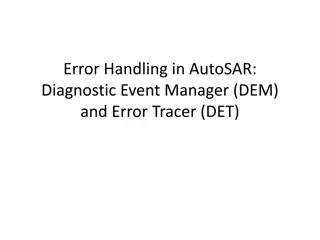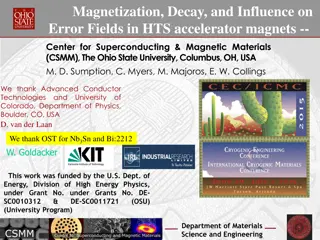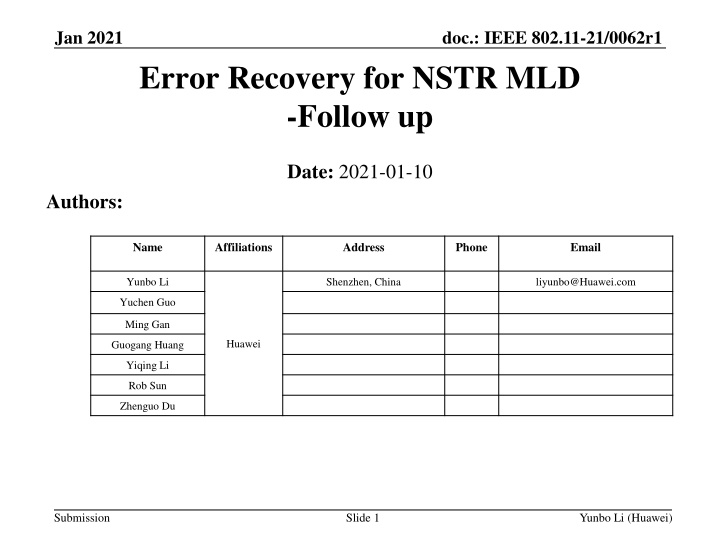
IEEE 802.11-21/0062r1 Jan. 2021 Error Recovery for NSTR MLD
Explore the error recovery process for NSTR MLD in IEEE 802.11-21/0062r1, focusing on the use of different IFS timings for successful link recovery. Detailed examples and scenarios are discussed to understand the approach better.
Download Presentation

Please find below an Image/Link to download the presentation.
The content on the website is provided AS IS for your information and personal use only. It may not be sold, licensed, or shared on other websites without obtaining consent from the author. If you encounter any issues during the download, it is possible that the publisher has removed the file from their server.
You are allowed to download the files provided on this website for personal or commercial use, subject to the condition that they are used lawfully. All files are the property of their respective owners.
The content on the website is provided AS IS for your information and personal use only. It may not be sold, licensed, or shared on other websites without obtaining consent from the author.
E N D
Presentation Transcript
doc.: IEEE 802.11-21/0062r1 Jan 2021 Error Recovery for NSTR MLD -Follow up Date: 2021-01-10 Authors: Name Affiliations Address Phone Email Yunbo Li Shenzhen, China liyunbo@Huawei.com Yuchen Guo Ming Gan Huawei Guogang Huang Yiqing Li Rob Sun Zhenguo Du Submission Slide 1 Yunbo Li (Huawei)
doc.: IEEE 802.11-21/0062r1 Jan 2021 Background A NSTR MLD is allowed to use an IFS larger than SIFS on the successful link to do error recovery according to below Motion; The exact number of this IFS is TBD for now; Further details are discussed in this presentation. In R1, after two PPDUs with end time alignment (and the PPDUs carrying the expected response frames are also with end time alignment) are transmitted by a NSTR MLD on link 1 and link 2 respectively, STA 1 affiliated with this NSTR MLD may use an IFS greater than SIFS between the ending time of PPDU carrying the successful response frame and a following PPDU within a TXOP on link 1 when PHY-RXSTART.indication is received but FCS is not correct for response frame on link 2. STA 1 shall transmit the following PPDU only if the ED CS mechanism indicates that the medium is idle; The concrete value for the IFS greater than SIFS is TBD, with an upper limit of PIFS; The response frames are frames sent from STAs affiliated with the peer MLD in the TXOP in response to the frames carried in the previous PPDUs. [Motion 146, #SP346, [30] and [263]] Submission Slide 2 Yunbo Li (Huawei)
doc.: IEEE 802.11-21/0062r1 Jan 2021 Recap This is a high level example to show how to resolve the error recovery problem for a NSTR MLD in [1]; As mentioned in [2], PPDU ending time alignment need to be considered in this scenario; The proper IFS that can be used will be discussed in the following slides. SIFS SIFS SIFS PIFS SIFS STA11 PPDU10 PPDU11 PPDU12 link1 BA11 BA12 CTS BA10 STA12 PIFS SIFS SIFS SIFS SIFS STA21 PPDU20 PPDU21 PPDU21 link2 BA21 BA21 CTS BA20 STA22 Submission Slide 3 Yunbo Li (Huawei)
doc.: IEEE 802.11-21/0062r1 Jan 2021 Error Recovery for non-STR MLD -Case 1 Case 1 BA11 is successfully received on link1, BA21 is failed to be received on link2; The ending time of BA11 is later than the ending time of BA21 with a time t; When the starting time of PPDU12 and PPDU21 are perfectly aligned, IFS on link1 equals to PIFS t; Starting time of PPDU12 and PPDU21 with an offset that less or equal to 4us will not affect the ED sensing before PPDU12 and PPDU21 . So the IFS on link1 could be PIFS t 4us. SIFS SIFS SIFS SIFS STA11 t PIFS-t PPDU10 PPDU11 PPDU12 link1 BA11 BA12 BA10 STA12 PIFS SIFS SIFS SIFS SIFS STA21 PPDU20 PPDU21 PPDU21 link2 BA21 BA21 BA20 STA22 Submission Slide 4 Yunbo Li (Huawei)
doc.: IEEE 802.11-21/0062r1 Jan 2021 Error Recovery for non-STR MLD -Case 2 Case 2 BA11 is successfully received on link1, BA21 is failed to be received on link2; The ending time of BA21 is later than the ending time of BA11 with a time t; When the starting time of PPDU12 and PPDU21 are perfectly aligned, IFS on link2 equals to PIFS t; Starting time of PPDU12 and PPDU21 with an offset less or equal to 4us will not affect the ED sensing before PPDU12 and PPDU21 . So the IFS on link2 could be PIFS t 4us. PIFS SIFS SIFS SIFS SIFS STA11 PPDU10 PPDU11 PPDU12 link1 BA11 BA12 BA10 STA12 SIFS SIFS SIFS SIFS t PIFS-t STA21 PPDU20 PPDU21 PPDU21 link2 BA21 BA21 BA20 STA22 Submission Slide 5 Yunbo Li (Huawei)
doc.: IEEE 802.11-21/0062r1 Jan 2021 Error Recovery for non-STR MLD -Case 3 Case 3 BA11 is failed to be received on link1, BA21 is failed to be received on link2; The ending time of BA21 is later than the ending time of BA11 with a time t; When the starting time of PPDU11 and PPDU21 are perfectly aligned, IFS on link2 equals to PIFS t; Starting time of PPDU11 and PPDU21 with an offset less or equal to 4us will not affect the ED sensing before PPDU11 and PPDU21 . So the IFS on link2 could be PIFS t 4us. PIFS SIFS SIFS SIFS SIFS STA11 PPDU10 PPDU11 PPDU11 link1 BA11 BA11 BA10 STA12 SIFS SIFS SIFS SIFS t PIFS-t STA21 PPDU20 PPDU21 PPDU21 link2 BA21 BA21 BA20 STA22 Submission Slide 6 Yunbo Li (Huawei)
doc.: IEEE 802.11-21/0062r1 Jan 2021 IFS for the later ending BA is success t is the time difference of ending time of BAs on two links; The shadow area shows the possible IFS range for each different t; When the IFS is greater than PIFS, it will violate the regulation; It is not acceptable to allows IFS shorter than SIFS; In conclusion, [SIFS, PIFS] is the IFS range for the case that later ending BS is success. IFS Violate the regulation PIFS+4us Suggest IFS range PIFS PIFS-4us SIFS < SIFS should not be allowed PIFS-12us t=0us t=8us t Submission Slide 7 Yunbo Li (Huawei)
doc.: IEEE 802.11-21/0062r1 Jan 2021 IFS for the later ending BA is failed t is the time difference of ending time of BAs on two links; The shadow area shows the possible IFS range for each different t; When the IFS is greater than PIFS, it will violate the regulation; It required to find a minimum IFS range that could works for possible t that 8us; For the below figure, for the case later ending BA is failed the IFS range should be [PIFS-4us, PIFS]. IFS Violate the regulation PIFS+4us Suggest IFS range PIFS PIFS-4us Hard for implementation PIFS-12 t=0us t=8us t Submission Slide 8 Yunbo Li (Huawei)
doc.: IEEE 802.11-21/0062r1 Jan 2021 Summary From the summary in below table for all 3 cases, the IFS on the link with earlier ending BA will always be PIFS, and the IFS on the link with later ending BA will always between [PIFS-4us, PIFS]. Cases IFSs Case 1: Earlier ending BA is failed, Later ending BA is success Earlier IFS = PIFS, Later IFS =[SIFS, PIFS] Case 2: Earlier ending BA is success, Later ending BA is failed Earlier IFS = PIFS, Later IFS =[PIFS-4us, PIFS] Case 3: Earlier ending BA is failed, Later ending BA is failed Earlier IFS = PIFS, Later IFS =[PIFS-4us, PIFS] Submission Slide 9 Yunbo Li (Huawei)
doc.: IEEE 802.11-21/0062r1 Jan 2021 Summary Base on the analysis, it is suggest that: After two PPDUs with end time alignment (and the PPDUs carrying the expected response frames are also with end time alignment) are transmitted by a MLD on two links of a NSTR link pair respectively, when PHY- RXSTART.indication is received but FCS is not correct for response frame on one link while successful receive the response frame on another link, or PHY-RXSTART.indication is received but FCS is not correct for response frame on both links, below IFSs before next PPDU on each link are allowed for error recovery the IFS on the link with earlier ending response frame will be PIFS; the IFS on the link with later ending response frame is a value between [SIFS, PIFS] if the later ending response frame is successful; the IFS on the link with later ending response frame is a value between [PIFS-4us, PIFS] if the later ending response frame is failed. Note: when the two response frames with the same ending time, any one of the two response frames can be the earlier ending response frame or later ending response frame. Slide 10 Submission Yunbo Li (Huawei)
doc.: IEEE 802.11-21/0062r1 Jan 2021 Reference [1] 11-20-1062-05-00be-error-recovery-for-non-str-mld [2] 11-20-1278-00-00be-error-recovery-in-synchronous-multiple-frame- transmission Submission Slide 11 Yunbo Li (Huawei)
doc.: IEEE 802.11-21/0062r1 Jan 2021 Straw Poll 1 In R1, do you agree that after two PPDUs with end time alignment (and the PPDUs carrying the expected response frames are also with end time alignment) are transmitted by a MLD on two links of an NSTR link pair respectively, when PHY-RXSTART.indication is received but FCS is not correct for response frame on one link while successful receive the response frame on another link, or PHY-RXSTART.indication is received but FCS is not correct for response frame on both links, below IFSs before next PPDU on each link are allowed for error recovery the IFS on the link with earlier ending response frame will be PIFS; the IFS on the link with later ending response frame is a value between [SIFS, PIFS] if the later ending response frame is successful; the IFS on the link with later ending response frame is a value between [PIFS-4us, PIFS] if the later ending response frame is failed. Note: when the two response frames with the same ending time, any one of the two response frames can be the earlier ending response frame or later ending response frame. Submission Y/N/A = Slide 12 Yunbo Li (Huawei)

